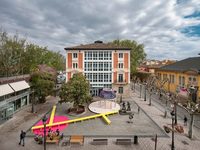LWL – Museum for Art and Culture
Münster, Germany
After a perennial construction period the LWL Museum for Art and Culture in Munster has been re-opened in September. Extended by Staab Architekten through a new construction which is connected with the existing building from 1908, the museum can now display its collection in 51 exhibition spaces. They are flanked by a library, an auditorium, access and relaxation zones as well as a restaurant. The carefully structured lighting concept of Licht Kunst Licht not only offers a flexible exhibition illumination, but also orchestrates the architecture.
It was the lighting designer's aim to develop a lighting concept that measures up to the museum as a multifunctional building but also fulfills the elevated requirements of a display illumination in a contemporary museum's operation. The design focus was not on the luminaire as an object but on the self-evident integration of artificial light into a clear-cut architecture, thus making light palpable, but keeping the light source itself concealed.
Apart from the approach to the new museum's architectural structure, Licht Kunst Licht has tackled the task of guiding the visitor through the building's interiority by light, thus accompanying him like a leitmotif on his way through the museum from the first step into the foyer to the exhibition spaces at the 3rd floor. Simultaneously, it was of pivotal importance that various requirements of exhibition illumination are covered by a connecting lighting element throughout all areas. This was to provide the possibility of a flexible lighting solution for the permanent and temporary exhibitions.
At the exhibition spaces, a so far unique lighting solution has been specifically developed for this museum. A ceiling integrated artificial lighting frame, following the walls' outlines creates a calm ceiling impression and provides flexible light for the unrestricted display of exhibits. Following the groove between the lighting frame and the central ceiling area is a
3-phase-track. It allows for the flexible adaptation of projectors. In their narrow beam version they accentuate selected works of art or illuminate larger areas and objects in their wide beam edition.
Also the approach to daylight and the visitor's visual link with the exterior was a particular challenge in the exhibition spaces with skylights and the foyer. At the uppermost floor, the museum houses five skylight spaces. Large, centered daylight ceilings allow the dynamics of natural light into the interior space. In order to avoid the detrimental effects of direct sunlight, a laminated glass sandwich has been fitted with a micro-prismatic layer. It only admits diffuse sky light. The amount of light can be reduced through a roller blind. Yet another layer allows for a complete black-out. A translucent membrane ceiling facing the interior acts as an additional filter. In order to achieve an artificial light atmosphere at the skylight spaces that is identical to the one in the remaining exhibition areas, a combination of the aforementioned light frame and track mounted projectors is implemented.
- Lighting Designers
- LICHT KUNST LICHT
- Location
- Münster, Germany
- Year
- 2014
- Client
- Landschaftsverband Westfalen - Lippe
- Team
- Martina Weiss, Laura Sudbrock
- Architects
- Staab Architekten GmbH
Related Projects
Magazine
-
-
-
-
Un despatx madrileny signa un visionari catalitzador urbà en West Palm Beach
Andrea Pala | 29.11.2018 -
L'arquitectura de Francis Keré en escena en el Museu ICO de Madrid
Andrea Pala | 28.10.2018














